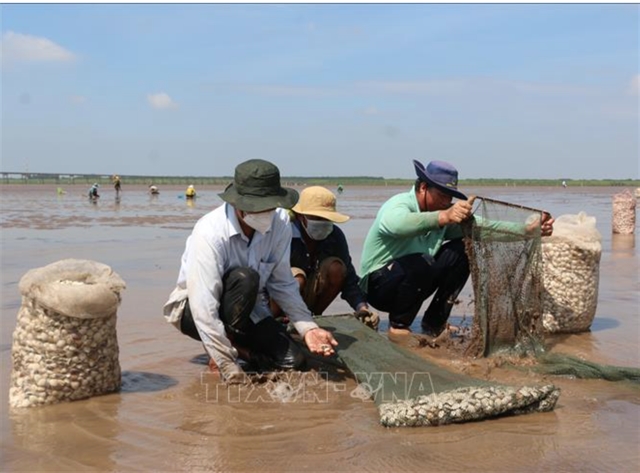 Society
Society

 |
| Farmers harvesting clams in Bạc Liêu Province. — VNA/VNS Photo |
TRÀ VINH — The long coast of the country is an advantage for clam farmers expanding exports, especially deep-water clam farmers.
Vietnamese clams, especially white clams, have great competitiveness in the world market because clam farms have been developed in many provinces in coastal areas.
Vietnamese white clams can be processed into more products than other clams in the world. So, deep-water clam farming is a great opportunity for Việt Nam.
According to statistics by the Fishery Department, Việt Nam currently has over 41,500ha of molluscs, mainly bivalve molluscs, with an output of about 265,000 tonnes per year, of which, the output of clams reaches 179,000 tonnes per year.
The mollusk farming value chain creates about 200,000 jobs.
The international market demand for shellfish is very high. However, the clam harvest in Việt Nam has not yet met the orders from Europe.
With the current strengths of Vietnamese clams, the clam farming, processing and exporting industry needs a quality-focused direction to meet the standards of the importing markets.
Lê Thanh Lựu, director of the International Collaborating Centre for Aquaculture and Fisheries Sustainability (ICAFIS), said that in order to develop the clam industry, it is necessary to develop certification according to Aquaculture Stewardship Council (ASC) standards.
This is an international certification for responsible aquaculture that minimise adverse effects on the environment, ecosystem and community, and ensures good regulations on labour, Lựu said.
In addition, the development of deep-water clam farming will contribute to creating quality clams as desired by the market, Lựu said.
Today's modern mechanised technology, which is convenient for harvesting and monitoring deep-water clam farming, will open up a large area for clam farming in Việt Nam, he said.
Huỳnh Hoàng Thành, director of Long Thành Agricultural Co-operative, an ASC certified unit in Châu Thành District of Trà Vinh Province, said that achieving ASC certification has opened many great opportunities for his business.
The certified clam production and care process is more secure and professional, meeting the needs of both domestic and international markets, Thành said.
Thereby, clam farming as per ASC standards helps the cooperative’s members have many opportunities to expand the market and attract many clients while the cooperative can actively control output in production and increase the value of clam products, the director said.
“In deep-water clam raising, shifting from single fishing to co-operative production has helped small producers apply technical innovations that require more investment resources but bring higher output values, such as clam breeding conservation techniques, deep-water clam farming and exploitation, and cleaning and sorting before packing,” Lựu said.
“Co-operatives also have more advantages with designing their own clam brands and packaging, helping proactively access to the market compared to the past when households only sold harvested clams to traders,” he said.
According to Trần Thanh Dũng, deputy director of Department of Agriculture and Rural Development of Trà Vinh Province, to develop the white clam industry in the long term, the province has transferred the technology of clam breeding production and rearing to the co-operatives and strengthened monitoring and warnings to identify safe farming areas as well.
Moreover, the province has also improved trade promotion activities, market research and a system of providing market information to clam farmers.
Fishery departments have actively updated market information, including prices, output and demand through the mass media as well as enhanced linkages so that co-operatives and farmers have a stable and reasonable supply of breeds and outlets, Dũng said.
By the end of last year, Vietnamese clams were present in 56 international markets, including the six big markets of Europe, the US, Japan, Korea, ASEAN and China.
In the first three months of this year, the export turnover of clams reached about US$30 million.
With this market potential, the clam industry sets itself a path to overcome market challenges and achieve long-term stability, said Lựu. — VNS




